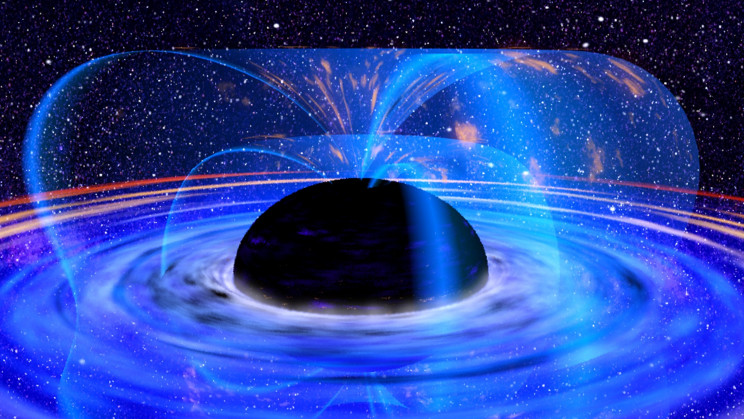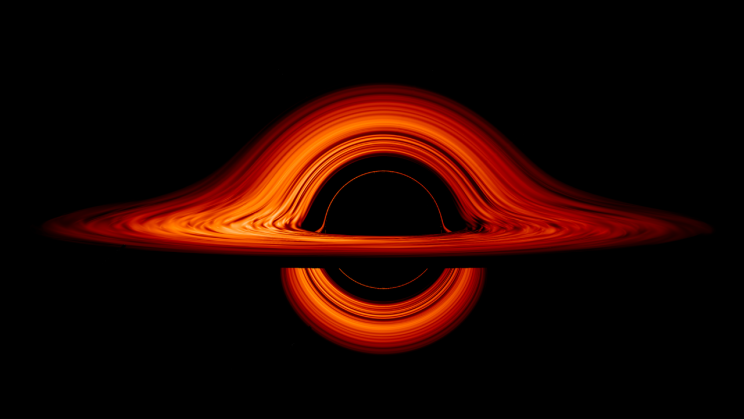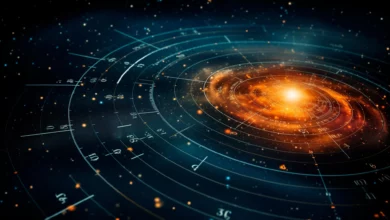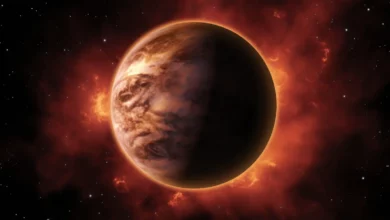
Lead Image: Artist’s impression of a black hole accretion disk
We’ve all heard how the gravity of a black hole is so powerful that not even light is able to escape it.
This inevitably leads to the impression that the boundary of a black hole is the metaphorical one-way trip into the abyss, and that a black hole simply grows larger forever as it gobbles up more and more of the universe around it.
Generally, this is true, but in an almost folktale-like way, one of the tiniest phenomena known to physics is thought to be capable of slowly but steadily chipping away at a black hole bit by bit until there is nothing left and it’s as if the black hole had never existed at all.
This phenomenon, known as Hawking radiation, is one of the most improbable quirks of quantum mechanics but it shows how nothing, not even black holes, can skirt the law of conservation of energy.
What is the event horizon of a black hole?
To understand how a black hole can simply evaporate out of existence, we need to brush up on some of the physics around black holes, literally.
When a star of sufficient size, starting around nine to 10 solar masses and running as large as 100 solar masses, runs out of fuel to burn, the outward force of its nuclear furnace is no longer enough to hold back the force of its own gravity.
When this happens, a spectacular collapse occurs with speeds approaching 229.6588 ft/s that may or may not produce a supernova, depending on the star’s mass and composition.
In some cases, the force of gravity during this collapse is so strong that nothing can prevent a collapse towards zero volume and infinite density. A singularity then forms at a single point in space with all of the mass of the collapsed star, which produces a remarkable phenomenon.
All massive bodies in the universe have an escape velocity, which is the velocity needed to overcome the gravitational pull of the body, and the required velocity increases as you get closer to an object’s center of gravity.
With black holes, there is a distance from the center below which the escape velocity exceeds the speed of light, which is the fastest anything in the universe can move. As a result, the event horizon forms around the singularity at this radius, known as the Schwarzschild radius, beyond which nothing can ever escape, not even the teeniest, tiniest particles.
What is Hawking Radiation?
There is a weird quirk of quantum field theory that says that every square unit of volume in the universe is absolutely roiling with quantum fluctuations produced by what are known as virtual particles.
Virtual particles are the spontaneous and transient creation and instantaneous destruction of particles and anti-particles in a vacuum. In the normal course of events, these fluctuations would have no effect on the larger universe, since the virtual particles don’t have time to do anything other than annihilate each other.
These quantum fluctuation effects are happening constantly, all around us, and are otherwise not particularly notable—except along the edge of an event horizon.

Even though these particles exist on a quantum scale, they occupy real space, and sometimes particles appear along the edge of a black hole’s event horizon.
When this happens, the two particles don’t have time to annihilate each other before one half of the pair gets sucked into the black hole, while the other is able to shoot away into space and escape as a form of black body thermal radiation known as Hawking radiation.
Can black holes really just evaporate?
Hawking radiation is a big no-no, however, since there’s no such thing as free energy in the universe. Energy can neither be created nor destroyed, it can only be converted into different kinds of energy.
All the energy that exists has always existed and will always exist. In the end, the universe’s ledger must balance, so how do we account for the sudden addition of Hawking radiation that did not exist before one half of a virtual particle pair was swallowed up by a black hole?
Fortunately, while the newly emitted Hawking radiation is escaping off into the wider universe, that infalling virtual particle is actually carrying in negative energy as a debit to the Hawking radiation’s credit.
This keeps the universe’s energy ledger balanced by reducing the energy of the black hole by a commensurate amount as was released in the form of Hawking radiation.
And since energy can be converted to mass and vice versa (E=MC2 and all), that negative energy becomes negative mass added to the black hole, effectively subtracting that mass from the total.
This reduction in mass is about as small as you can get in real terms, but the surface of the event horizon is absolutely boiling with Hawking radiation.
This has a death-by-a-gajillion-cuts effect on the black hole, and if the black hole doesn’t add more mass by consuming matter, over a very long time, it will lose all of its mass to Hawking radiation.
How often do black holes evaporate?
It isn’t known how often this process has happened, but it’s likely that the minuscule primordial black holes which were formed after the Big Bang have long since evaporated away. Astronomers hope that there are still some extant out there in the universe, though, since they are probably the only way we will ever see such evaporation take place.
It is theorized that an evaporating black hole will come to its end when it approaches one Planck mass and two Planck lengths, at which point it is hypothesized that the black hole evaporates with a violent explosion of gamma rays.
Astronomers and physicists have been on the lookout for just such a gamma-ray burst, but have yet to find one and it’s possible that we never will.
As for larger, stellar mass and intermediate-mass black holes, if one were somehow created in the intergalactic medium in such as way that it doesn’t come into contact with anything at all for about 1070 years, it is possible for one of these larger black holes to evaporate away.
Considering that this is orders of magnitude longer than the lifetime of the universe, it’s likely that no black hole of this size has ever evaporated away in this manner in the life of the universe.
As for black holes within a galaxy or other similar cosmic structures, there is too much available material for Hawking radiation to even begin to make a dent in a black hole’s mass, since a black hole will simply accrete more mass than it radiates away.
As for supermassive black holes, well, you can forget about that. It would take Sagittarius A* 1087 years to evaporate from Hawking radiation, and for Ton 618, the largest black hole ever discovered (weighing in at a staggering 66 billion solar masses), it would take more than 10100 years for it to evaporate away.
These are heat-death-of-the-universe timescales, and in reality, Hawking radiation and evaporating black holes will only ever really be a thing of consequence long after every star in the universe has died out and all of space-time is an infinite cosmic crypt.
Hawking radiation and the black hole information paradox
Beyond the theoretical intricacies of Hawking radiation and black hole evaporation, the most consequential effect of Hawking radiation is what’s known as the black hole information paradox.
This is produced by the conflict between two competing rules governing Hawking radiation on the one hand and quantum field theory on the other.
Hawking radiation has been shown to have no encoded information in it and has no connection to any previous Hawking radiation, meaning that it does not carry with it any information originating from its entangled partner particle that fell into the black hole.
If no information is transmitted through Hawking radiation, then all information that falls into a black hole remains inside the black hole forever. This is important for quantum field theory, which holds as a fundamental rule that information cannot be irretrievably lost.
Scrambled out of all order, yes. Locked away inside a black hole never to be seen again, sure; so long as the black hole containing it still exists, that information still exists somewhere in the universe and can theoretically, maybe be reconstituted one day by a process we haven’t yet discovered.
This is the crux of the paradox since Hawking radiation does not transmit information out of the black hole but it does predict that all black holes will eventually evaporate out of existence, taking whatever information they contained with them in violation of quantum field theory.
There have been many attempts to reconcile Hawking radiation with the law of information conservation, but none have produced a satisfying solution to the problem, and they have even produced additional problems for physicists to tangle with.
One such related paradox is known as the black hole firewall paradox, which takes the Black Hole Information Paradox and layers on an extra violation of what theoretical physicist Joe Polchinski and others have called the “no drama” principle of black hole complementarity, forcing physicists into the uncomfortable position of having to sacrifice one of the three well-established theories.
Needless to say, Hawking radiation has been a controversial topic for physicists ever since Hawking proposed it in 1974, and unfortunately, experimental evidence using sonic black holes demonstrates that Hawking radiation is a real phenomenon that can’t be ignored.
How Hawking radiation eventually gets reconciled with the rest of physics is anyone’s guess, but it will keep on bubbling away along event horizons everywhere like a gentle stream carving out a mighty canyon.





